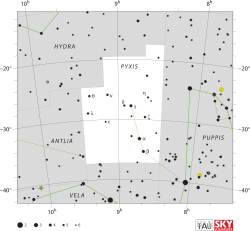Alfa Pyxidis
| Alfa Pyxidis (α) | |
 | |
| Observationsdata Epok: J2000.0 | |
|---|---|
| Stjärnbild | Kompassen |
| Rektascension | 08t 43m 35,53756s[1] |
| Deklination | -33° 11′ 10,9898″[1] |
| Skenbar magnitud () | +3,67[2] |
| Stjärntyp | |
| Spektraltyp | B1.5 III[3] |
| U–B | -0,84[2] |
| B–V | -0,19[2] |
| Variabeltyp | Beta Cephei-variabel (BCEP)[4] |
| Astrometri | |
| Radialhastighet () | +15,3[5] km/s |
| Egenrörelse (µ) | RA: -14,27[1] mas/år Dek.: +10,43[1] mas/år |
| Parallax () | 3,71 ± 0,14[1] |
| Avstånd | 880 ± 30 lå (270 ± 10 pc) |
| Absolut magnitud () | -3,47[6] |
| Detaljer | |
| Massa | 10,7[4] M☉ |
| Radie | 6,3 ± 1,0[7] R☉ |
| Luminositet | 10 000[4] L☉ |
| Temperatur | 24 300[8] K |
| Metallicitet | -0,18[8] dex |
| Vinkelhastighet | 11[9] km/s |
| Andra beteckningar | |
| α Pyxidis, CPD-32° 2399, FK5 327, HD 74575, HIP 42828, HR 3468, SAO 199546. [10] | |
Alfa Pyxidis (α Pyxidis, förkortat Alfa Pyx, α Pyx) som är stjärnans Bayerbeteckning, är en ensam stjärna belägen i den sydvästra delen av stjärnbilden Kompassen. Den har en skenbar magnitud på 3,67[2] och är synlig för blotta ögat. Baserat på parallaxmätning inom Hipparcosuppdraget på ca 3,7[1] mas, beräknas den befinna sig på ett avstånd på ca 880 ljusår (ca 270 parsek) från solen.
Egenskaper[redigera | redigera wikitext]
Alfa Pyxidis är en blå jättestjärna av spektralklass B1.5 III[3] och är en Beta Cephei-variabel. Den har en massa som är ca 11[4] gånger större än solens massa, en radie som är ca 6,3[7] gånger större än solens och utsänder från dess fotosfär ca 10 000[4] gånger mera energi än solen vid en effektiv temperatur på ca 24 000[8] K.
Stjärnor som Alfa Pyxidis med en massa av mer än 10 solmassor förväntas avsluta sitt liv genom att explodera som en supernova.[11]
Källor[redigera | redigera wikitext]
- Den här artikeln är helt eller delvis baserad på material från engelskspråkiga Wikipedia, tidigare version.
Referenser[redigera | redigera wikitext]
- ^ [a b c d e f] van Leeuwen, F. (November 2007), "Validation of the new Hipparcos reduction", Astronomy and Astrophysics, 474 (2): 653–664, arXiv:0708.1752 , Bibcode:2007A&A...474..653V, doi:10.1051/0004-6361:20078357
- ^ [a b c d] Fernie, J. D. (May 1983). "New UBVRI photometry for 900 supergiants". Astrophysical Journal Supplement Series. 52: 7–22. Bibcode:1983ApJS...52....7F. doi:10.1086/190856.
- ^ [a b] Hiltner, W. A.; Garrison, R. F.; Schild, R. E. (July 1969). "MK Spectral Types for Bright Southern OB Stars". Astrophysical Journal. 157: 313. Bibcode:1969ApJ...157..313H. doi:10.1086/150069.
- ^ [a b c d e] Hubrig, S.; et al. (January 2009). "New magnetic field measurements of beta Cephei stars and Slowly Pulsating B stars". Astronomische Nachrichten. 330 (4): 317. arXiv:0902.1314 . Bibcode:2009AN....330..317H. doi:10.1002/asna.200811187.
- ^ Wilson, R. E. (1953). General Catalogue of Stellar Radial Velocities. Carnegie Institute of Washington D.C. Bibcode:1953GCRV..C......0W.
- ^ Anderson, E.; Francis, Ch. (2012), "XHIP: An extended hipparcos compilation", Astronomy Letters, 38 (5): 331, arXiv:1108.4971 , Bibcode:2012AstL...38..331A, doi:10.1134/S1063773712050015.
- ^ [a b] Hubrig, S.; Ilyin, I.; Schöller, M.; Briquet, M.; Morel, T.; De Cat, P. (January 2011), "First Magnetic Field Models for Recently Discovered Magnetic β Cephei and Slowly Pulsating B Stars", The Astrophysical Journal Letters, 726 (1): L5, arXiv:1012.3019 , Bibcode:2011ApJ...726L...5H, doi:10.1088/2041-8205/726/1/L5
- ^ [a b c] Kilian, J. (February 1994). "Chemical abundances in early B-type stars. 5: Metal abundances and LTE/NLTE comparison". Astronomy and Astrophysics. 282 (3): 867–873. Bibcode:1994A&A...282..867K.
- ^ Nieva, M. F.; Przybilla, N. (April 2008). "Carbon abundances of early B-type stars in the solar vicinity. Non-LTE line-formation for C II/III/IV and self-consistent atmospheric parameters". Astronomy and Astrophysics. 481 (1): 199–216. arXiv:0711.3783 . Bibcode:2008A&A...481..199N. doi:10.1051/0004-6361:20078203.
- ^ "NSV 4220 -- Variable Star". SIMBAD. Centre de Données astronomiques de Strasbourg. Hämtad 2010-02-23.
- ^ Reed, B. Cameron (June 28, 2005). "New Estimates of the Solar-Neighborhood Massive-Stars Birthrate and the Galactic Supernova Rate". The Astronomical Journal. 130 (4): 1652. arXiv:astro-ph/0506708 . Bibcode:2005AJ....130.1652R. doi:10.1086/444474.
Externa länkar[redigera | redigera wikitext]
| |||||||||||||||||||





